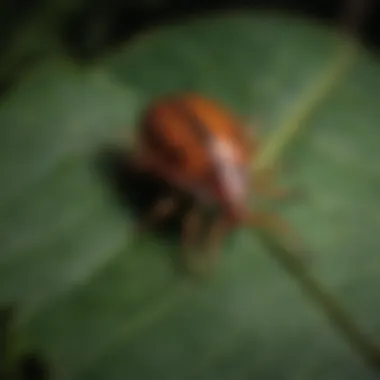Effective Methods for Eradicating Lone Star Ticks


Intro
Lone star ticks have become a growing concern in many regions, particularly in the southern United States. The presence of these ticks raises various health risks, primarily related to tick-borne diseases. However, the potential hazards extend beyond just personal health; they also disrupt the comfort and safety of residential spaces. As such, understanding the methods for eradicating these ticks is essential for homeowners.
This article aims to provide a detailed examination of effective methods for managing lone star ticks in domestic environments. We will cover the identification techniques, prevention strategies, and practical steps for removal, creating a resource for anyone seeking to maintain a tick-free home. Through this discussion, we will underscore the importance of addressing these concerns not only for personal health but also for ensuring a healthy living environment.
Forest Ecology and Biodiversity
Addressing the issue of lone star ticks can benefit from a broader understanding of forest ecology and biodiversity. Ticks thrive in environments that support their lifecycle, which often includes wooded and brushy areas. The ecological balance maintained in such environments is crucial.
Importance of Forest Ecosystems
Forested ecosystems play a significant role in the larger environmental context. They provide habitats for various species and maintain biodiversity, which in turn supports ecosystem services vital for human well-being. Forests also act as natural barriers against tick populations by promoting a diverse range of flora and fauna that can disrupt the ticks' life cycle through predation and competition.
Flora and Fauna in Woodlands
Lone star ticks find their primary hosts among the fauna that inhabit forested regions. Animals like white-tailed deer, raccoons, and various rodents are commonly associated with tick activity. Maintaining the health of woodland environments can help control tick populations indirectly by promoting biodiversity, which provides natural checks and balances within the ecosystem.
By fostering a vibrant forest ecosystem, homeowners can diminish the likelihood of ticks migrating into their residential areas. Thus, integrating forest management practices with tick control strategies can yield more effective results in eradicating lone star ticks.
Prevention Strategies
To effectively manage lone star ticks, prevention is key. Implementing strategies can greatly reduce the chance of ticks entering a home.
Landscaping Adjustments
Homeowners should consider altering their landscaping. Keeping grass short, removing tall weeds, and creating buffer zones around properties are effective measures. Such adjustments can reduce habitats conducive for ticks.
Natural Repellents
Using natural repellents can also be a useful tool in prevention. Essential oils like geranium and neem can deter ticks when applied correctly. Homeowners can explore eco-friendly options that do not adversely affect the beneficial insects in their gardens.
Practical Removal Methods
When ticks are discovered in the home, prompt action must be taken to ensure effective eradication.
Identification of Tick Presence
Proper identification is imperative for effective removal. Homeowners should familiarize themselves with the visual characteristics of lone star ticks, including their distinctive white dot on the shield-like scutum.
Safe Removal Techniques
To remove ticks from the body, it is crucial to apply the right techniques:
- Use fine-tipped tweezers to grasp the tick close to the skin.
- Pull upward with steady, even pressure without twisting or jerking.
- Clean the bite area and your hands with rubbing alcohol, an iodine scrub, or soap and water.
"Understanding ticks' biology and behavior is essential for anyone dealing with infestations or prevention strategies."
Finale
Prelude to Lone Star Ticks
Understanding the nature and behavior of lone star ticks is crucial for any homeowner who wishes to maintain a safe living environment. These ticks can pose various health risks, making it essential to establish effective strategies for their identification and eradication. This section serves to enlighten readers on what lone star ticks are and their impact on household ecology.
Defining Lone Star Ticks
Lone star ticks, scientifically known as Amblyomma americanum, are easily recognizable due to their distinct characteristics. Adult males tend to have a thicker build, while females exhibit a prominent white spot on their back, which led to their common name. These ticks have a lifespan that includes several stages: egg, larva, nymph, and adult. Each stage has unique characteristics. They are primarily found in wooded or brushy areas, where they wait to latch onto unsuspecting hosts.


Recognizing lone star ticks involves understanding their size and color variations. Adult ticks can range from 3 to 5 mm in length and typically appear reddish-brown. Knowledge of these details aids in effective monitoring and control measures.
Historical Distribution and Ecological Impact
Historically, the distribution of lone star ticks has expanded across the southeastern and central regions of the United States. Their presence is increasing in northern territories, likely due to climate change and habitat alteration. This expansion raises significant ecological concerns for homeowners.
From an ecological standpoint, lone star ticks contribute to the spread of various tick-borne diseases, such as ehrlichiosis and southern tick-associated rash illness. Such diseases not only affect human health but can also have repercussions for pets and local wildlife. This interconnectedness within the ecosystem emphasizes the importance of eliminating these ticks to protect both household members and the overall environment.
"The expansion of lone star tick populations indicates a growing challenge for homeowners and pest control efforts."
Understanding the intricate relationship between these ticks, their preferred habitats, and the diseases they transmit is vital. Knowledge in these areas equips homeowners with the capability to implement targeted prevention and eradication strategies. As such, this detailed examination of lone star ticks establishes a foundation for addressing the upcoming sections, which will focus on identification, prevention, and removal techniques.
Identifying Lone Star Ticks
Identifying Lone Star Ticks is a critical aspect of managing these pests effectively. Early recognition of these ticks can prevent larger infestations and reduce associated health risks. Understanding the specific characteristics of Lone Star Ticks allows homeowners to detect their presence before the situation escalates. Knowledge about the lifecycle of these ticks is equally important, as it reveals when they are most active and vulnerable, informing prevention and elimination strategies.
Physical Characteristics
Lone Star Ticks possess distinct physical features that differentiate them from other tick species. Adult female ticks are easily identified by their prominent white spot on the back. This unique mark is not present in males, which have a more uniform brownish coloration. Males tend to be smaller, typically measuring around 3 to 4 mm, while females can grow up to 10 mm, particularly when engorged with blood.
Here are some key identifying characteristics:
- Shape: These ticks have a flat, oval shape that becomes more rounded when engorged.
- Coloration: Adult females are reddish-brown with a white dot, while males are darker with less contrast.
- Mounting: Their legs and mouthparts are noticeable, making them different from many insects.
Accurate identification is crucial for those living in tick-prone areas. Misidentifying ticks can lead to inadequate responses, potentially resulting in health risks.
Life Cycle Stages
The Lone Star Tick undergoes four main life stages: egg, larva, nymph, and adult. Each stage presents different vulnerabilities and requires unique approaches for effective management. Understanding these stages enables homeowners to develop targeted eradication strategies.
- Egg Stage: The life cycle begins when adult female ticks lay hundreds of eggs in the spring. These eggs hatch into larvae after a few weeks, depending on environmental conditions.
- Larva Stage: Larvae emerge in late summer. They seek hosts for their first blood meal and usually feed on birds and small mammals. This stage is when ticks spread to new areas.
- Nymph Stage: After feeding, larvae molt into nymphs. They remain inactive throughout winter and become active again in the spring, now seeking larger hosts. Nymphs are responsible for transmitting pathogens to humans.
- Adult Stage: Once engorged, nymphs molt into adults in the fall. Adult males seek females for mating. Females will lay eggs after feeding, continuing the cycle.
By recognizing these stages, homeowners can implement effective methods for eradicating Lone Star Ticks when they are vulnerable, ultimately reducing their presence in residential spaces.
Understanding the Risks
Understanding the risks associated with lone star ticks is crucial for any homeowner aiming to manage their environment effectively. The potential threats these ticks pose go beyond general discomfort. They can have serious implications for both human health and ecological balance. Being aware of these risks enables homeowners to take informed actions to protect their family and property.
Health Concerns Associated with Lone Star Ticks
Lone star ticks are known vectors for several diseases that can impact human health. The most notable is ehrlichiosis, an infection caused by bacteria transmitted through tick bites. Symptoms may include fever, chills, and fatigue. If left untreated, it can lead to severe complications such as respiratory failure or kidney damage. Furthermore, some people may develop a rare but serious allergic reaction to red meat after being bitten by a lone star tick, known as Alpha-gal syndrome. This condition can lead to life-threatening allergic reactions when consuming mammal-based food products.
Another concerning aspect is that the presence of lone star ticks can also contribute to the spread of diseases affecting pets. Keeping your domestic animals protected is essential, especially as some ticks can transmit illnesses that could affect their health as well.
Environmental Impact of Tick Infestations
Tick infestations can cause significant ecological issues as well. Lone star ticks can disrupt local wildlife populations. Their presence can lead to a decline in some species, particularly those that are unable to cope with the heavy burden of tick-related diseases. This imbalance can affect the entire ecosystem, as the decline in one species can have a ripple effect.
"Preventing tick infestations is not only about personal safety; it is also about preserving local biodiversity and ecosystem health."
Additionally, areas heavily infested by ticks may experience changes in land usage. For instance, landowners may avoid using certain parts of their property for recreational activities or gardening, leading to reduced usability of space. Effective management of lone star ticks is thus not just a personal concern but a community responsibility.
In summary, recognizing the health risks and environmental consequences associated with lone star ticks will help homeowners focus their eradication efforts. It supports a more holistic approach to pest control that benefits both families and communities, and promotes healthier ecosystems.
Preventive Measures
Preventive measures are crucial in the fight against lone star ticks. These ticks can carry diseases that pose severe health risks. By focusing on prevention, homeowners can create an environment that minimizes tick populations before they become an issue. The benefits of such measures extend beyond simply protecting human health; they also help maintain an ecological balance in residential areas.
Maintaining a Tick-Free Home Environment


To maintain a tick-free home environment, it is essential to implement several strategies. Regularly mowing the lawn and keeping it short is one effective way to deter ticks. Ticks prefer tall grass and dense vegetation, so reducing these habitats makes your property less attractive to them.
It is also important to clear leaf litter and yard debris. Areas like piles of leaves, logs, and even shrubbery can harbor ticks. Ensure that your yard is well organized and free of clutter. Consider installing fences to keep wildlife, such as deer or rodents, away from your home, as they may carry ticks.
The use of specific granular insecticides can also help. Products containing permethrin, or similar active ingredients, can be applied around the perimeter of the house and in gardens for added protection. Always follow the instructions on the label for safe and effective application.
Landscaping Considerations
Landscaping plays a significant role in preventing ticks. Choose plants that are less appealing to ticks. For instance, use hardwood mulch and create a barrier around your garden with gravel or landscaping stones to make it harder for ticks to travel into your yard.
Planting native flowers can attract birds that feed on ticks and other pests, creating a natural balance.
It is also advisable to create open spaces in your landscape. Wide clearings can help dry out humidity levels that ticks thrive in. A combination of dry areas with short grass promotes a less habitable environment for them.
Personal Protection Strategies
Personal protection strategies are vital when engaging in outdoor activities. Wearing appropriate clothing can reduce the risk of ticks attaching to skin. It is best to wear long sleeves and pants. Additionally, light-colored clothing helps in spotting ticks more quickly.
Using insect repellents that contain DEET or permethrin on skin and clothing is strongly recommended. Reapply according to the instructions on the product to ensure ongoing protection. After returning home, it is a good practice to thoroughly check yourself, pets, and any gear for ticks.
"By taking proactive steps, homeowners can greatly reduce the risk of tick infestations and protect themselves and their families from potential diseases."
Regularly washing clothes and gear after outdoor activities also minimizes the chance of ticks being brought inside. Ensuring that pets are treated with tick prevention products can further secure the household against any potential infestations.
Detecting Lone Star Ticks in the Home
Detecting lone star ticks within your home is crucial for managing the threat they pose. Early identification can prevent larger infestations, lower the risk of disease transmission, and maintain overall household hygiene. Understanding the signs and employing effective inspection techniques simplifies the mitigation process and increases the likelihood of effective eradication.
Signs of Infestation
Identifying signs of tick infestation is the first step in managing lone star ticks. Here are several indicators to look for:
- Actual Tick Presence: Look in areas where ticks often hide, such as behind furniture, in cracks of wood, or in places where pets often rest. Adult ticks are small and can be dark brown or black in color. Their size can range from 1/8 inch to 1/4 inch long.
- Skin Irritation or Bites: Observe for any unusual skin reactions, such as redness or swelling, particularly in family members or pets. These could indicate a bite from a lone star tick.
- Pet Behavior Changes: Pets may display signs of unease or excessive scratching if they are carrying ticks. Monitoring their behavior can give an early indication of a problem.
- Tick Droppings: Tiny black specks or small dark residues may indicate tick infestations. These droppings can often be found in high-traffic areas within your home.
"Identifying the signs of tick infestations can ensure timely intervention, reducing the risk of pet and human health hazards."
Taking action quickly upon recognizing these signs is vital for keeping your home tick-free.
Effective Inspection Techniques
Conducting effective inspections can lead to quicker detection of lone star ticks. Here are some techniques to consider:
- Routine Check-ups: Schedule regular inspections in areas that may attract ticks. Such locations include your yard, pet resting areas, and storage spaces.
- Visual and Physical Inspections: Use your eyes and hands effectively to detect ticks. Examine pets, carpets, and furniture thoroughly.
- Sampling Techniques: For more thorough inspections, consider using light-colored cloth or sticky tape.
- Tick Identification: Familiarize yourself with the characteristics of lone star ticks to distinguish them from other types. Each tick stage has unique features that can help in identifying them during inspections.
- Search systematically, focusing on potential hiding spots.
- Inspect your clothing and shoes after outdoor activities.
- Check under cushions and inside seams where ticks might hide.
- You may wish to use a flashlight to see into darker corners.
- Drag the cloth across suspected infested areas to catch ticks.
- Utilize sticky tape in corners where ticks might be present.
Developing a proactive approach to inspections will help in minimizing risks associated with lone star ticks. These actions are part of a long-term strategy to keep your home as tick-free as possible.
Removal Strategies
Implementing effective removal strategies is essential for managing lone star ticks within your home. These strategies not only help eliminate existing infestations but also protect against future invasions. It is crucial to address both immediate and long-term solutions. Homeowners must consider the implications of various removal methods, balancing effectiveness with safety and environmental impact.
Home Remedies for Tick Elimination


Home remedies can provide a cost-effective and immediate solution for tick removal. While some might argue about their efficacy when compared to commercial solutions, they often serve as a practical first step.
Essential Oils: Many essential oils are known for their insect-repelling properties. For instance, oils such as tea tree oil, lavender, and eucalyptus can deter ticks. Mixing a few drops with water in a spray bottle allows homeowners to create a natural repellent.
Vinegar Solutions: Vinegar, particularly apple cider vinegar, can also act as a deterrent. Mixing vinegar with water can create a solution for spraying areas susceptible to ticks. This method may not kill ticks but has shown to reduce their presence.
Diatomaceous Earth: This naturally occurring substance can be sprinkled around your yard and home. Diatomaceous earth works mechanically, damaging the tick's exoskeleton, leading to dehydration and death. Care should be taken to apply it in areas where pets and children do not frequently roam.
These remedies can be used in combination with good hygiene practices. Regularly washing bedding, vacuuming carpets, and sealing cracks can further minimize tick infestations.
Professional Pest Control Options
When home remedies fail or the infestation is severe, professional pest control may be necessary. Professionals offer targeted treatments with more potent methods that can ensure complete eradication of lone star ticks.
Chemical Treatments: Pest control companies often utilize pesticides specifically designed to target ticks. Some of these chemicals are applied as barrier treatments around the perimeter of your property, creating a protective zone against ticks. Certain pesticides have residual effects, meaning they can continue to repel ticks over time.
Integrated Pest Management (IPM): A comprehensive approach combining various methods, IPM involves not just chemical solutions but also habitat management techniques. Experts may recommend modifying landscaping to reduce tick habitats, such as eliminating tall grasses and removing leaf litter, to create a less hospitable environment for ticks.
"Choosing professional service ensures that eradication strategies are both effective and aligned with safety guidelines, protecting your home and family from potential harm."
Follow-Up Treatments: A single treatment might not completely eradicate an infestation. A professional service may offer follow-up treatments, ensuring that any remaining ticks are eliminated. Regular checks after initial treatments help maintain a tick-free environment.
Both home remedies and professional options have their respective merits. Homeowners should evaluate their specific situations and decide on the best course of action based on the severity of the infestation and their comfort level with various methods.
Post-Removal Practices
Successful tick removal does not conclude your efforts; rather, it marks the beginning of ongoing vigilance. Post-removal practices are pivotal in ensuring that your home remains a safe environment. These practices focus on monitoring, maintenance, and proactive strategies that address potential tick re-infestations. This section highlights two critical components of post-removal care: monitoring for recurrences and establishing long-term management plans. By adhering to these practices, homeowners can significantly reduce the likelihood of future tick problems.
Monitoring for Recurrences
Monitoring is an essential component of effective pest management. After addressing the immediate problem of tick infestations, it becomes crucial to systematically check for signs of their return. Regular inspections can help in identifying new ticks or eggs early on. Homeowners should routinely examine areas where ticks thrive. Focus on:
- Yard and Landscaping: Inspect vegetation and shaded areas, as these are likely hiding places for ticks.
- Pets: Regularly check your pets for ticks, especially after they spend time outdoors. Bathing and grooming can also aid in detection.
- Households: Look for ticks in clothing, wood piles, or sealed boxes where ticks may have entered.
Using tick traps or baited stations can enhance your monitoring efforts. These instruments help to gather data about tick populations over time, allowing for a better understanding of the threat level in your vicinity. Having a routine in place promotes better awareness and enables swift action should ticks reappear.
Long-Term Management Plans
Establishing effective long-term management plans is integral to controlling lone star ticks. The focus should be on creating an environment that does not support tick populations. Consider the following strategies:
- Landscaping Modifications: Keep lawns well-maintained by mowing regularly. Use mulch and stone barriers to minimize tick habitats around the home.
- Pesticide Use: If you opt for chemical control, working with a pest control professional to identify appropriate products is advisable. Ensure treatments are spaced throughout the growing season to provide consistent protection.
- Integrated Pest Management (IPM): Adopting a holistic approach encompasses both preventative measures and reactive strategies. This might include habitat modification, use of biocontrol agents, and community awareness programs.
"A well-documented long-term plan is your best defense against tick resurgence."
Fostering a community environment aware of tick management increases the overall effectiveness of your strategies. Discussing these practices with neighbors can extend the reach of prevention efforts, as ticks travel and may easily spread from one property to another.
In summary, post-removal practices are a comprehensive means of ensuring your home stays free from lone star ticks in the future. Continuous monitoring and thoughtful long-term management plans cultivate a proactive stance, essential for maintaining a safe living environment.
End
In this article, the significance of dealing with lone star ticks in residential areas is thoroughly examined. Ticks, particularly the lone star tick, can pose substantial health risks not only to humans but also to pets and livestock. Because of this, it is crucial for homeowners to adopt effective methods for eradication.
By implementing comprehensive strategies that encompass identification, removal, and long-term management, the safety and hygiene of the living environment can be maintained.
Proper monitoring and proactive measures can lead to effective home management against ticks.
Summary of Key Points
- Identification: Recognizing the characteristics and life stages of lone star ticks is vital for effective prevention and eradication. Early detection helps limit infestation.
- Prevention Strategies: Creating a clutter-free environment, using protective landscaping methods, and applying personal protective measures are essential to reduce tick exposure.
- Removal Techniques: Utilizing home remedies and professional pest control services are integral in effectively addressing infestations, ensuring that the tick population is managed efficiently.
- Post-Removal Practices: Consistent monitoring and implementing long-term management plans can help prevent re-infestation, making your home a less hospitable environment for ticks.
Future Considerations for Homeowners
As the ecological landscape shifts due to climate change and urbanization, the behaviors and habitats of lone star ticks may evolve. Homeowners should consider adopting the following:
- Continual Education: Staying informed about tick behaviors and the latest removal techniques can empower homeowners to act swiftly.
- Community Involvement: Engaging in community-wide tick prevention programs can enhance the effectiveness of individual efforts. Collective actions can lead to a significant reduction in tick populations.
- Health Monitoring: Being vigilant about health implications of tick bites is critical. Homeowners should maintain awareness of associated diseases and seek medical advice when necessary.















